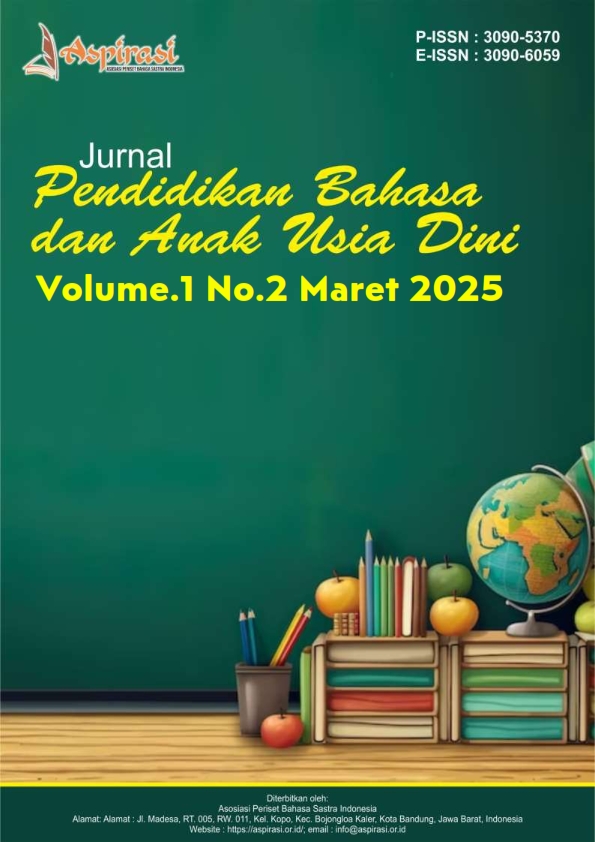Deskripsi Penggunaan Gadget Melalui Pelayanan Paud Holistik Integratif di TK Negeri Pembina Salakan
DOI:
https://doi.org/10.61132/jupenbaud.v1i4.63Keywords:
Gadgets, Early Childhood, Holistic Integrative PAUD, Salakan State Kindergarten, Negative ImpactsAbstract
he digital era brings significant changes in various aspects of life, including early childhood (ECD) parenting patterns. Easy access to gadgets ultimately results in excessive use that has a negative impact on children's growth and development. This study aims to examine strategies for overcoming the impact of excessive gadget use on ECD through optimizing Holistic Integrative Early Childhood Education (PAUD HI) services at TK Negeri Pembina Salakan. The methods used are literature studies and participatory observations of the implementation of the PAUD HI program. The results of the study indicate that the PAUD HI approach that includes integrated education, health, nutrition, care, protection, and welfare services can be an effective solution. At TK Negeri Pembina Salakan, its implementation is realized through learning activities that stimulate all aspects of development, active involvement of parents in digital parenting education, provision of an environment rich in non-gadget stimulation, and collaboration with health services and the community. It is concluded that PAUD HI has a strategic role in mitigating the negative risks of gadgets and supporting optimal growth and development of ECD.
References
AAP Council on Communications and Media. (2016). Media and young minds. Pediatrics, 138(5), e20162591. https://doi.org/10.1542/peds.2016-2591
Hana Pebriana Putri. (2017). Analisis penggunaan gadget terhadap kemampuan interaksi sosial pada anak usia dini. Riau: PGSD FIP Universitas Pahlawan Tuanku Tambusai.
Hidayati, N., & Sari, Y. P. (2019). Dampak penggunaan gadget terhadap perkembangan sosial anak usia dini. Jurnal Obsesi: Jurnal Pendidikan Anak Usia Dini, 3(2), 446–453. https://doi.org/10.31004/obsesi.v3i2.215
Kementerian Pendidikan dan Kebudayaan. (2015). Pedoman implementasi pendidikan anak usia dini holistik-integratif. Jakarta: Direktorat Pembinaan Pendidikan Anak Usia Dini.
Mimin, E. (2022). Analisis dampak penggunaan gadget terhadap aspek-aspek perkembangan anak usia dini. Jurnal Golden Age, 6(2), 112–120. (Tambahkan halaman jika tersedia.)
Peraturan Presiden Republik Indonesia Nomor 60 Tahun 2013 tentang Pengembangan Anak Usia Dini Holistik-Integratif.
Rahmawati, A., & Prastuti, E. (2020). Peran orang tua dalam mengontrol penggunaan gadget pada anak usia dini. Jurnal Ilmiah Potensia, 5(1), 20–29. https://doi.org/10.33369/jip.5.1.20-29 (Tambahkan DOI jika tersedia.)
Santrock, J. W. (2018). Life-span development (17th ed.). McGraw-Hill Education. (Gunakan edisi terjemahan jika yang digunakan versi bahasa Indonesia.)
Sugiyono. (2017). Metode penelitian kuantitatif, kualitatif, dan R&D. Bandung: Alfabeta.
Sunita, & Mayasari. (2018). Pengawasan orangtua terhadap dampak penggunaan gadget pada anak. Jurnal Endurance, 3(3), 510–514. https://doi.org/10.22216/jen.v3i3.2485
World Health Organization. (2019). Guidelines on physical activity, sedentary behaviour and sleep for children under 5 years of age. Geneva: World Health Organization.





